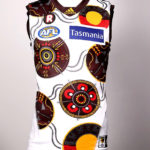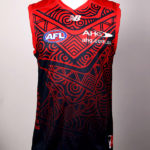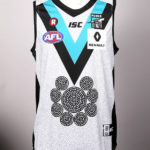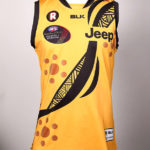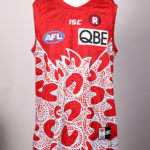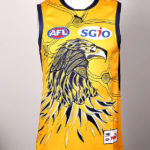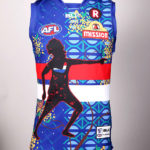2016 Indigenous Round guernseys (2/2)Hawthorn, designed by Jirra Lulla Harvey with assistance from Shaun Burgoyne, Bradley Hill, Cyril Rioli and Jermaine Miller-Lewis.
This design represents the players and them joining together on the land of the Wurundjeri (of the Birrarung (Yarra River) Valley). It captures the players’ different journeys through individual motifs that give an insight into their life outside football and their cultural identities. A special feature of the Indigenous Guernsey is a short story from each Indigenous player that sits inside the collar of the Guernsey. (x)Melbourne, designed by Mandy Nicholson with assistance from Jay Kennedy-Harris, Jeff Garlett and Neville Jetta
The design features the wangim in flight mode depicting speed and fitness and connecting the attributes of the original game of Marngrook and the modern game. The wangim are embedded into the Birrarung river (Yarra) to show the connection to the traditional custodians of Melbourne, the Wurundjeri people. The names of every Indigenous player to have represented the Melbourne Football Club are featured on the sides of the guernsey.(x)North Melbourne, designed by Sarrita and Tarisse King
The jumper combines the striking styles of the King sisters and provides an aerial view of the land. Dividing the pair’s work is a thick line – the bloodline – a symbol of their connection to each other and the land. (x)Port Adelaide, designed by Karl Amon
The guernsey design symbolises the club’s eight Aboriginal players – Amon, Chad Wingard, Jarman Impey, Jake Neade, Aidyn Johnson, Nathan Krakouer, Brendon Ah Chee and Paddy Ryder – in the eight circles surrounding a larger central circle. The large circle is symbolic of the whole Port Adelaide Football Club – its players, coaches, staff, volunteers and supporters.(x)Richmond, designed by Patricia “Trish” McKean
Trish is a Kirrae Whurrong woman from Warrnambool, who has been involved with the Club’s Korin Gamadji Institute for the past 3 years. The story of the Guernsey aligns with Reconciliation Australia’s theme for 2016: ‘Our history, our story, our future’ For The Past, Present, and the Future Players and our people. Minkgill (meaning star in Kirrae Whurrong language; the five dots that surround a main dot and run down beside the curved image) are the symbols used to represent the star players past, present and future. The curved image between the Minkgills’ is like the river of life that flows through time from the beginning to the present and into the future, winding like a Rainbow Serpent, creating new beginnings and a bright future as it goes(x)St Kilda, designed by Marcus Lee
Represents the six Boonwurrung clans that live in harmony. The design features six circles that symbolically refers to the Boonwurrung Bay region, extending along the shorelines of Port Phillip Bay, Mornington Peninsula and Western Port to Wilsons Promontory.(x)
Sydney Swans, designed by Lisa Sansbury
The artwork represents the Indigenous communities of Sydney, telling the tale of them coming together around Sydney’s harbour and estuaries.(x)
West Coast Eagles, designed by Peter Farmer
Tells the story of the waalitj (wedge-tailed eagle), the strongest totem in Noongar culture. The artwork includes tracks which connect to six fresh water sources in WA. Featured is an image of the waalitji, painted ready for ceremony and attack. The traditional Noongar dreaming story is about a great drought; the animals and Noongar people could not find any freshwater sources. The waalitj’s eye was the only one that could find water from searching high up in the sky; the Noongar people followed him at this time of great hardship and adversity, and always found a fresh water source. The moral of the story is through great adversity, the waalitj finds a path. His strength and power is respected and revered throughout Noongar country, because of his capacity to not simply overcome adversity, but to succeed in places that others fail. (x)Western Bulldogs, designed by ‘The Pitcha Makin Fellas’ from Ballarat
The figure in the centre of the Guernsey known as the Great Black Pointer is a reference to a traditional figure in the history of the Indigenous people, pointing the way for us and others, giving direction and showing a path to follow; open your eyes and see what is around you but also remember the past and what is important. It is also a reference to the courageous people in our community who stand against injustice. The boomerang in the chest of the figure is a reference to the traditional ways of the Indigenous community and for this guernsey; the boomerang has been painted in traditional Bulldogs colours of red, white and blue. The pattern in the background is from the artists’ own painting called ‘Blackmanland- The Fellas Coat of Arms’ which embraces their strong sense of themselves and their country. The design features the Golden Wattle and the big blue of the Australian sky.(x)

Just another WordPress site
